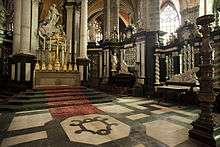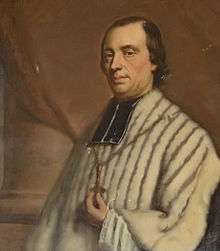St Bavo's Cathedral, Ghent
_Ghent_Belgium_October.jpg)

The Saint Bavo Cathedral (also known as Sint-Baafs Cathedral, or in Dutch Sint Baafskathedraal) an 89-meter-tall Gothic cathedral in Ghent, Belgium. It is the seat of the diocese of Ghent, is named for Saint Bavo of Ghent, and contains the well-known Ghent Altarpiece.
Description
The building is built on the site of the former Chapel of St. John the Baptist, a primarily wooden construction that was consecrated in 942 by Transmarus, Bishop of Tournai and Noyon. Traces of this original structure are evident in the cathedral's crypt.
The chapel was subsequently expanded in the Romanesque style in 1038. Some traces of this phase of expansion are still evident in the present day crypt.
In the subsequent period from the 14th through 16th centuries, nearly continuous expansion projects in the Gothic style were executed on the structure. A new choir, radiating chapels, expansions of the transepts, a chapter house, nave aisles and a single tower western section were all added during this period. Construction was considered complete June 7, 1569.
In 1539, as a result of the rebellion against Charles V, the old Abbey of St. Bavo was dissolved. Its abbot and monks went on to become canons in a Chapter that was attached to what then became the Church of Saint Bavo. When the Diocese of Ghent was founded in 1559, the church became its cathedral. The church of Saint Bavo was earlier the site of the baptism of Charles V.
Interior
Organs
The cathedral has four organs at disposal for liturgical celebrations.[1] Most famous is the main organ in the Upper church: is the biggest organ in the benelux. In 1935 Mgr Coppieters commanded that the Klais organ from the world exheboition would be put inside the cathedral. The organ case dates from the 18th century and the complete organ has more than 6000 pipes inside. It has 5 manuals.[2]
Ghent Altarpiece

The cathedral is noted for the Ghent Altarpiece, originally in its Joost Vijd chapel. It is formally known as: The Adoration of the Mystic Lamb by Hubert and Jan van Eyck. This work is considered Van Eyck's masterpiece and one of the most important works of the early Northern Renaissance, as well as one of the greatest artistic masterpieces of Belgium.[3]
Other religious art
The cathedral is home to works of other artists of note. It holds the painting Saint Bavo enters the Convent at Ghent by Peter Paul Rubens. There are also works by or after Lucas de Heere, one of which is a View of Gent. Frans Pourbus the Elder painted 14 panels representing the History of Saint Andrew (1572) and a Triptych of Viglius Aytta (1571). Caspar de Crayer is represented by paintings of St Macarius of Gent, The Beheading of Saint John the Baptist and The Martyrdom of Saint Barbara. The church also holds works by Antoon van den Heuvel including the Christ and the Adulterous Woman and the Resurrection of Christ. There are also works by Lucas van Uden and Jan van Cleef.[4]
Choir
The most impressive part is the high choir with stables for the members of the Chapter of Saint-Bavon. The episcopal Throne is put on the right side with the episcopal arms visible. Highlights of the interior decoration of the choir include the Baroque high altar (1702–1782), in white, black and red flamed marble, the tomb monuments of Ghent bishops, including that of Antonius Triest, in white and black marble (1652–1654), a major work of Jerôme Duquesnoy (II) On the right side is the gallery with painted crests of the members of the Golden Fleece.
Nave
In the nave we find an impressive rococo pulpit (1741–1745), made in oak, gilded wood and white and black marble by Laurent Delvaux, with wrought iron fence by J. Arens, There are also chairs designed by the contemporary designer Maarten Van Severen. The main altar is placed between the nave and the Choir.
Treasury and crypt
In the Chapel of the Holiest an important Calvary Triptych is on display. This 15th-century work is attributed to Justus van Gent. Finally a valuable collection of important liturgical Orfèvrerie, Relicaries and liturgical vessels from the 15th century until today. Amongst the relicries the important head Reliquiarie of Saint-John the Baptist and Saint Macarius can be admired. The Important collection of hand embriodered and brocated liturgical ornamentsis widely known as one of the most important of the country, some peaces are put on display.
Chapter of Saint-Bavo

Still today the chapter is housed inside the cathedral, since its foundation. Members have been import prelats and members of noble houses. Today Jozef De Kesel is one of the honorary canons. The chapters of Haarlem and Ghent are united in Friendship. Weekly the canons sing mass with the bishop.
- Maximilian van de Woestyne de Becelaere, died 1699: nephew of the Marquess of Becelaere.
- Jacques Ignace van Parys, died 1702 : grandson of Rubens.
- Constant van Crombrugghe
- François III Maria Rubens, died 1720: great grandson of Rubens.
- Petrus Joseph Triest, founder of the Brothers of Charity.
- Thomas-Philip d'Alsace, Cardinal.
- Antoon Stillemans, before he was ordained bishop.
- Gustaaf Joos, before he was created cardinal.
- Jozef De Kesel, honorary Canon.
- Lode Aerts, before he was ordained bishop.
Burials
- Cornelius Jansen (1510–1576), first Bishop of Ghent (1565–1576)
- Pieter Damant (1530-1609), third Bishop of Ghent (1589-1609)
- Karl vanden Bosch, Bishop of Ghent.
- Karel Justinus Calewaert, (1893–1963): 27th Bishop of Ghent (1948–1963).
- Prince Ferdinand de Lobkowitz (1726–1795) Bishop of Ghent, 1779–1795.
- Philippus Erardus van der Noot, baroque tomb by Jan Boeksent.
- Jan de Smet, Bishop of Ghent.
- Jan van de Velde (1779–1838), 20th Bishop of Ghent.
- Gerard van Eersel (died 1778), Bishop of Ghent.
- Ignace Schetz de Grobbendonk (1625–1680), 11th Bishop of Ghent (1679–1680).
- Michelle of Valois, Duchess of Burgundy.
See also
References
- ↑ http://www.sintbaafskathedraal.be/nl/kunstwerken/orgels.html
- ↑ http://www.andriessenorgelbouw.be/nl/GSB-info.html
- ↑ Kurtz, Michael J. (2006). America and the return of Nazi contraband. Cambridge University Press. p. 24.
- ↑ De Inventaris van het Bouwkundig Erfgoed, Sint-Baafskathedraal (ID: 25743) at Inventaris onroerend erfgoed (in Dutch)
External links
| Wikimedia Commons has media related to Sint Baafskathedraal. |


